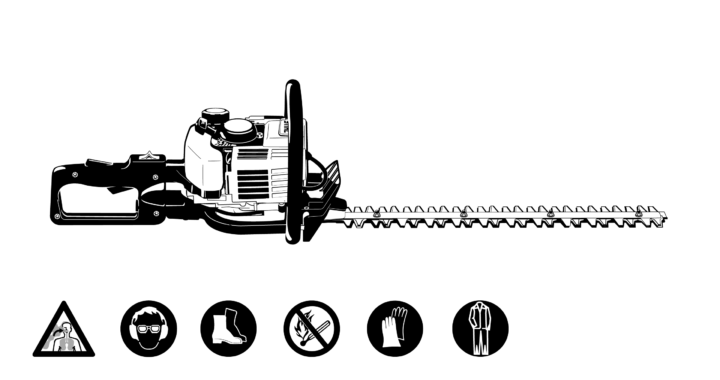Hedge Trimmers (Download)
Hedge Trimmer Safety Types of Hedge Trimmers Standard Hedge Trimmer Extended Length Hedge Trimmer Used for shrubs and small trees Generally 30- 40” Blades Used for trimming tall shrubs and s mall- mid size trees Generally 20- 30” Blades 42” arm length History of Hedge Trimmers In the past, garden shrubs and hedges were cut with manually-operated hand pruners and clippers. Gas/electric hedge trimmers were created to dramatically speed up the process of hedge trimming. Standard Hedge Trimmers Safety Hedge Trimmers have a safety button that must be depressed before the trigger is “live” This helps prevent misfires and careless injuries Potential hazard- The distance between blade prongs is about ¾ -1” wide This distance is large enough to amputate a finger or lacerate a body part Extended-Length Hedge Trimmer Pro- Longer reach allows user to prune hard to reach places Pro- Head pivots at 90 degree angle for easier straight-edge trimming Pro- Reduces the need for step-ladders; creating a safer work environment Con- Can be dangerous if an inexperienced worker cannot safely manage the “top heavy” weight of the blade Types of Standard Hedge Trimmers Electric Hedge Trimmer- Lighter than gasoline-operated hedge trimmers, but users risk electrocution . Battery-powered Hedge Trimmer- Lighter than gas powered but limited time use between battery recharges. Lithium batteries have helped to improve battery life but this type of hedge trimmer is still not practical for professional use. Types of Standard Hedge Trimmers Heavy-duty hedge trimmer: Chain spins at maximum RPM to produce high torque, which creates a hazard for users. While using a hedge trimmer at his professional lawn business, a business owner accidently hit his leg with the trimmer , and required12 stitches to close the wound. Hedge Trimmers in Construction Used in landscaping Landscaping does not occur until after construction is nearing completion, so hedge trimmers are usually not used until the post-construction process Safety Concerns Like with any automatic lawn tool, precautions must be taken when handling this tool. While its main purpose is to trim flora, if misused it can cause serious harm to the user. Hazards Associated with Gas Powered Trimmers Gas-powered trimmers require the use of a special gas/oil mix. If filled with standard gas, the engine may burn up. The exhaust port on the back of the hedge trimmer gets extremely hot after prolonged use. If accidently touched by the operator, it can cause severe burns. Hazards Associated with Gas-Powered Trimmers The chain movement inside the engine causes heavy vibrations which can loosen the gas/oil cap. If this cap comes off, the gas/oil mix can spill, creating a fire hazard in the work area Hazards Associated with Electric-powered Trimmers The number one danger when working with electric-powered trimmers is electrocution, such as when the extension cord is accidently cut Hazards Associated with Electric-powered Trimmers Always route the extension cord where it will not be accidently cut or where it cannot become a tripping hazard Always use ground fault circuit interrupters (GFCIs) to protect workers from electrocution Hazards Associated with Electric-powered Trimmers Never operate equipment in wet conditions If one MUST work in a wet area (recently watered) make sure to keep the contact (male/female) portions of the extension cord dry Carbon Monoxide Poisoning Hedge trimmers release carbon monoxide, much like any other gas-powered lawn equipment. The amount released generally is not very harmful. The real danger arises if the operator uses the trimmer indoors, where the carbon monoxide levels can raise to dangerously high levels. Its effects on the human body are almost unnoticeable until the user becomes unconscious, making it extremely dangerous. Source: Extracted from OSHA Accident Investigation Data 1990-2009 There were 0 construction worker fatalities that were investigated by OSHA from 1990 to 2009 There are no OSHA regulations that specifically mention or address the safe use of hedge trimmers Safe Work Practices Personal Protection Equipment When hedge trimming, the following equipment should always be worn Safety Glasses (Clear or UV protection) Work Gloves w/ Grip Hearing protection Personal Protective Equipment Wear long pants (preferably jeans) to protect against airborne debris and to help protect against hedge trimmer blades Wear closed toe shoes (preferably boots) Wear a respirator mask to prevent dust inhalation, when applicable Safe Work Practices When using the hedge trimmers, it is the operator’s duty to make sure bystanders (including pets) are not within the range of the hedge trimmers. Safe Work Practices Precautions must also be taken when filling gas-powered trimmers with gas . The user should only fill the tank about ¾ full to avoid spilling gas around the equipment. Equipment Inspections The hedge trimmers should be inspected periodically to check for loose parts and screws If there are any signs of rattling noises inside the engine, the equipment should be taken to a certified repair specialist Think Safety Work Safely

